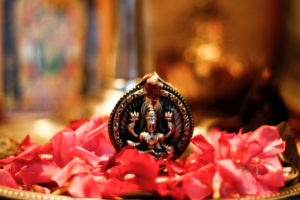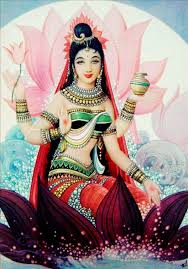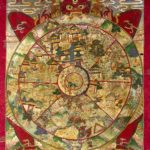Born in India, Hinduism reveres elements of the social life, various pieces of literature, and numerous rituals and practices, while striving for purity and to gain eternal Nirvana. In addition to being the world’s third-largest religion, Hinduism history tells of the social caste system, in which society was ranked according to class. The higher the occupation, the higher the level a person qualified in the caste system. For example, Brahmins were the highest on the caste system; they were the priests. Vaishyas were the farmers, laborers, and craftspeople. They were lower on the caste system. Furthermore, the Harijahns were considered the lowest on the caste system and the most impoverished. In its vastness, Hinduism employs 333 million deities/gods. Each one has an exclusive function. The higher on the caste system a Hindu was the more wealth Lakshmi would bestow upon them.
Lakshmi is the goddess of wealth, wisdom, and light.
Also known as a goddess of beauty, she is known for her motherly capabilities. She is the wife of Vishnu, who is part of the Hindu Trinity, and continued so throughout many reincarnations. Legend has it that she left in a sea of milk and was later reborn when the sea was churned; Vishnu promised the people that, when the sea was churned, Lakshmi would come back and bless those who churned. In fact, sometimes pictures of Lakshmi will show ambrosia. Vishnu said that when the sea was churned the sea would produce ambrosia, which in Greek mythology offers immortality and is the food of the gods. Legend also states that the demons and gods fought over Lakshmi. The gods prevailed and Lakshmi is now worshiped in most temples.
There are many physical attributes of Lakshmi that have various meanings.
For instance, the lotus seat that Lakshmi stands/sits upon represents a spiritual power that does not become self-righteous or egotistical, but one of purity. She is depicted as wearing very nice clothing and nice jewelry; two signs of wealth. She is also shown with elephants, and coins dropping from her hand.
 These represent the goodness of wealth and the importance of sharing the wealth with others. Lakshmi has four arms and hands; these also have their own symbolism. For example, ‘the four hands represent the ends of human life: dharma, Kama, moksha, and artha.(www.hindudevotion.com)” The two hands in the back symbolize the spiritual realm. Whereas, the two front hands symbolize the physical realm. The four arms are leading in all directions and representational that the power of Lakshmi is everywhere, at the same time, and shows no limits or boundaries.
These represent the goodness of wealth and the importance of sharing the wealth with others. Lakshmi has four arms and hands; these also have their own symbolism. For example, ‘the four hands represent the ends of human life: dharma, Kama, moksha, and artha.(www.hindudevotion.com)” The two hands in the back symbolize the spiritual realm. Whereas, the two front hands symbolize the physical realm. The four arms are leading in all directions and representational that the power of Lakshmi is everywhere, at the same time, and shows no limits or boundaries.
Hindus celebrate Lakshmi during the Festival of Lights, otherwise known as Diwali.
Diwali is a celebration that lasts for five days and symbolizes the power of good over evil. During Diwali there are numerous rituals and ceremonies that symbolize and request the bestowing of wealth from Lakshmi onto the Hindu and Jainist followers. (Cattle, money, animals, clothing, land, and material goods are all considered forms of wealth.) During the festival of lights, it is common for followers to place lights or lighted lamps in front of their homes and in the villages. The lamps, or lights, symbolize the power that light has over darkness, and that good has over evil. In preparation for Diwali and the coming of Lakshmi, Hindi people scour their homes and themselves top to bottom. It is said that Lakshmi dislikes filth and will not bless those with wealth. Towards the end of Diwali, Hindus line their lamps and/or lights, and some paint lotus flowers on their homes, and prepare to welcome the goddess Lakshmi.






